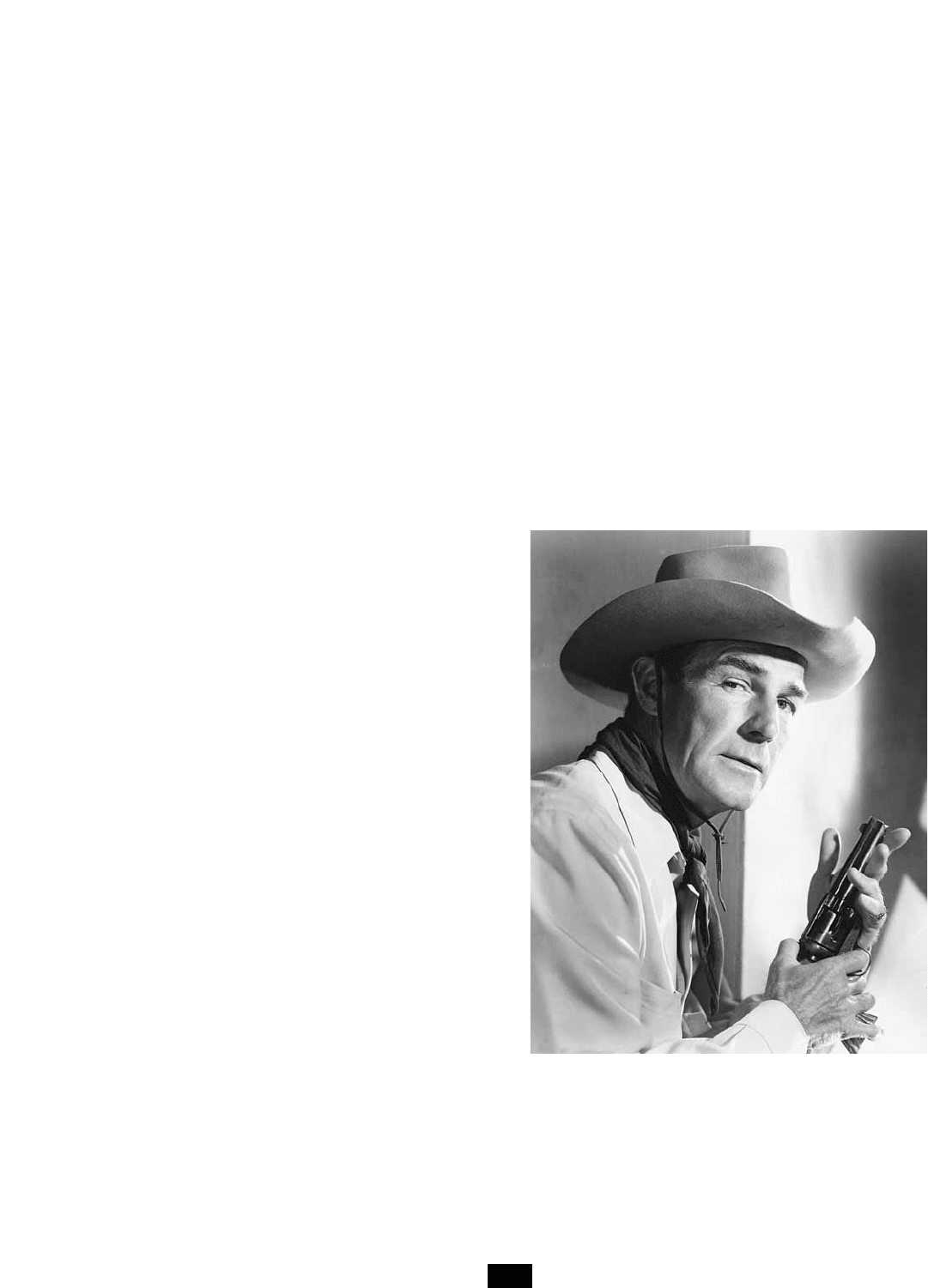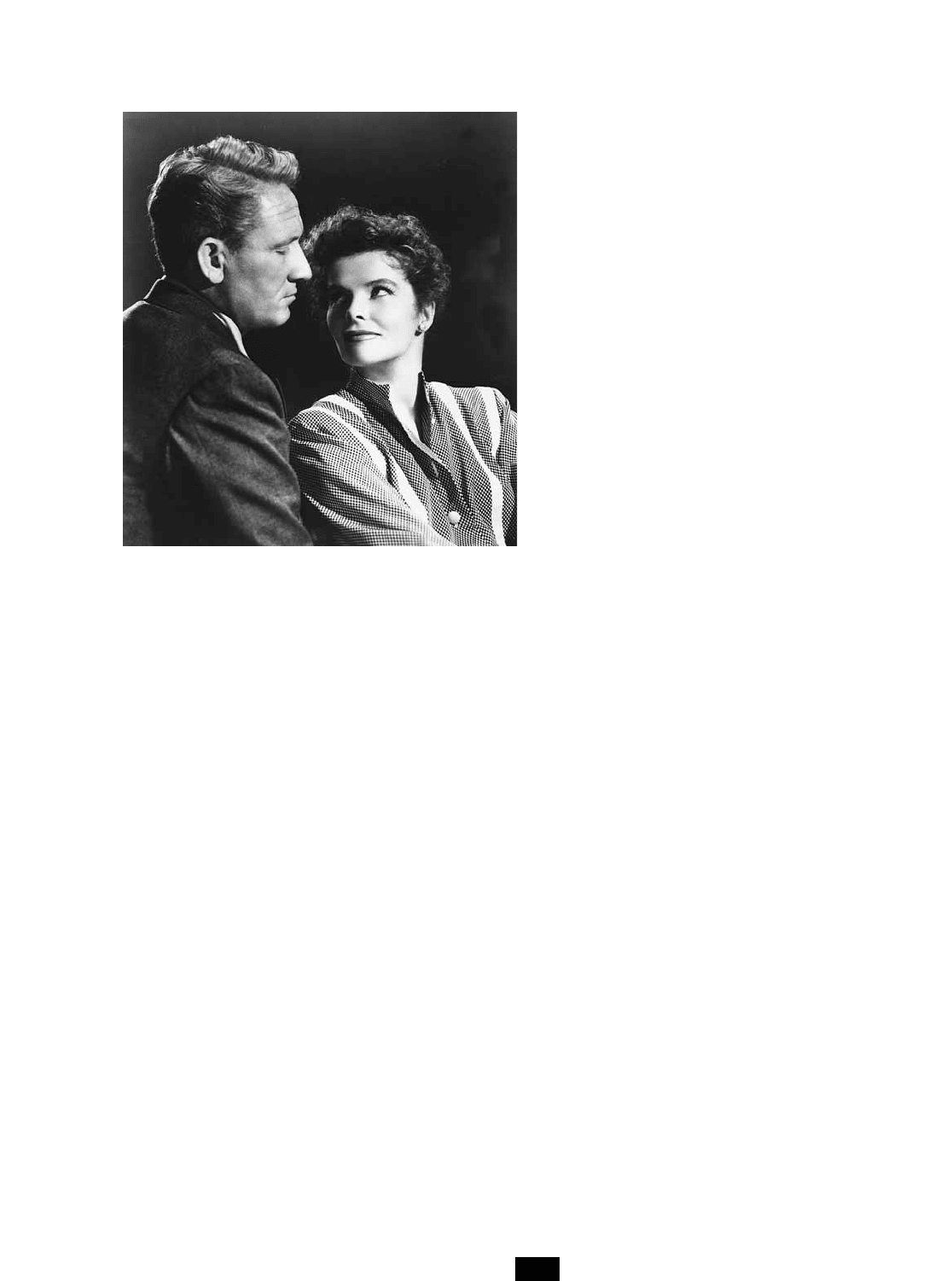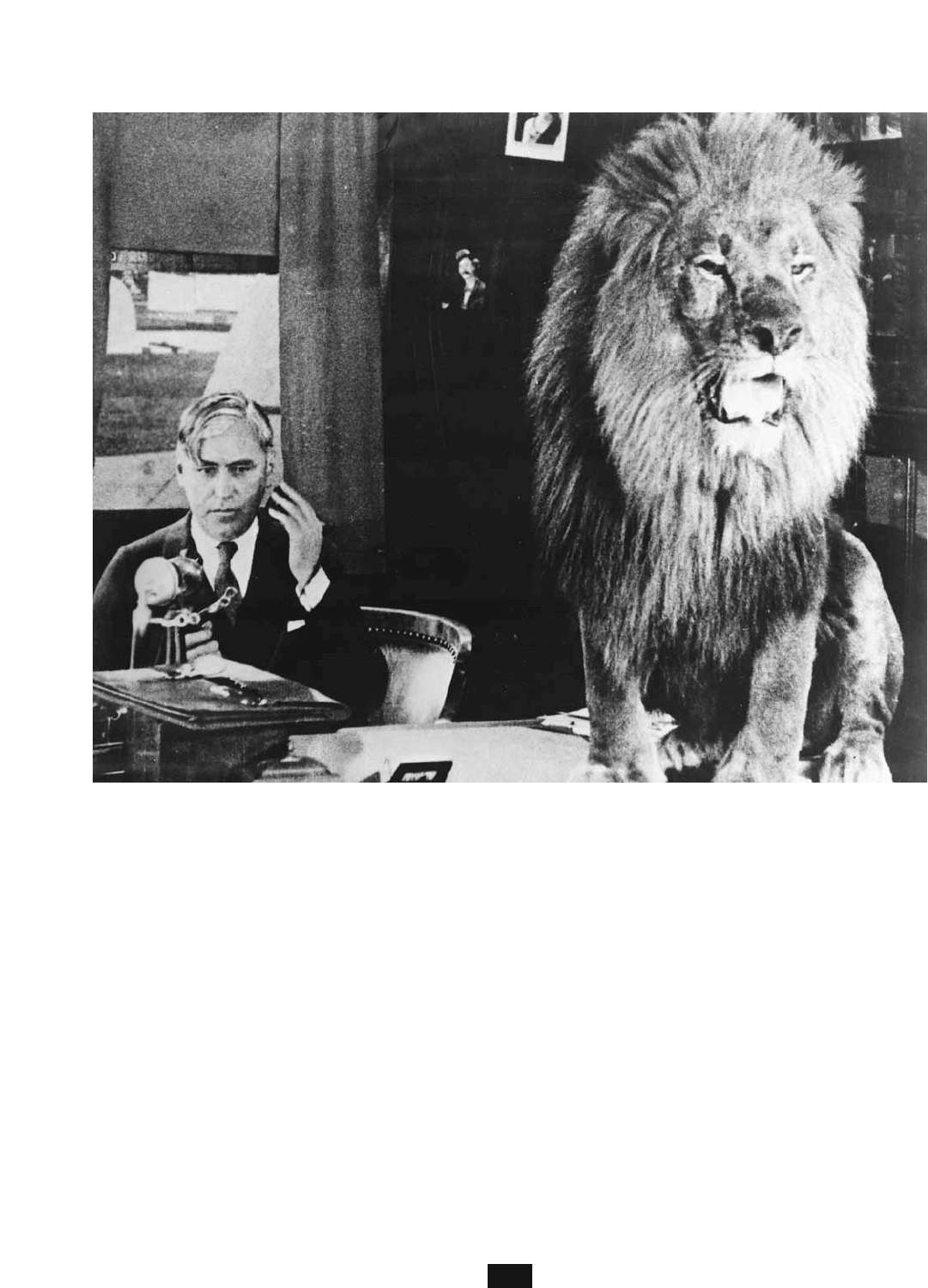Siegel S., Siegel B. The Encyclopedia Of Hollywood
Подождите немного. Документ загружается.


New York (1977) and when he changed gears altogether to
make a documentary about the rock group The Band’s final
tour called The Last Waltz (1978).
Scorsese almost always receives good reviews from the
critics but has had middling support at the box office. Raging
Bull (1979), for instance, was an artful attempt at making a
movie about a real-life character (boxer Jake La Motta)
whom the audience couldn’t easily like. The King of Comedy
(1983) was an audacious movie that satirized show-business
paths to success, once again creating a fascinating hero for
whom film fans felt little empathy. But the director managed
to express his themes and find commercial success once again
in After Hours (1985), a hard-edged comedy set in New York
City with a sympathetic hero.
Although his films have often been controversial, Scors-
ese outdid himself with The Last Temptation of Christ (1988), a
religious opus that offended a great many conservative Chris-
tians with the depiction of a brief erotic reverie while Jesus is
on the cross, suggesting that Christ might have considered
sleeping with (and marrying) Mary Magdalene. The storm of
protest engendered by the film helped turn what was a
thoughtful, quiet, art-house movie into a cause célèbre—and
a hit. The film also brought Scorsese a Best Director
ACAD
-
EMY AWARD
nomination.
While making Hollywood features, Scorsese has also
filmed low-budget documentaries, such as Italianamerican
(1974), a movie about his parents, and American Boy (1978), a
film about a friend from the 1960s. It would seem that Scors-
ese is a truly independent filmmaker who just happens to
make Hollywood movies.
In 1989 Martin Scorsese joined with Francis Ford Cop-
pola and
WOODY ALLEN
for the omnibus film New York Sto-
ries. A major effort was to follow in 1990, the remarkable
Goodfellas, starring Robert De Niro, Ray Liotta, and Joe
Pesci, which seemed to complete a cycle of New York films
for Scorsese that started with Mean Streets. Goodfellas won
British Academy Awards as Best Director and for Best
Adapted Screenplay (sharing the latter honor with Nicholas
Pileggi, who wrote the source book). Scorsese also had Acad-
emy Award nominations in the same two categories.
Scorsese’s next project was a remake of a noir classic, Cape
Fear (1991, from the 1961 original starring
ROBERT
MITCHUM
,
GREGORY PECK
, and Martin Balsam, all of whom
made cameo appearances in Scorsese’s remake). From this
crowd pleaser, Scorsese turned to adaptation with a version
of Edith Wharton’s New York novel, The Age of Innocence
(1993), starring Michelle Pfeiffer, Daniel Day-Lewis, and
WINONA RYDER
. For this, Scorsese and Jay Cocks were nom-
inated for an Academy Award for the Best Screenplay
adapted from another medium. Scorsese won the Best Direc-
tor award from the National Board of Review.
Then, back to the mob with Casino (1995), starring Scors-
ese regulars Robert De Niro as Sam Rothstein and Joe Pesci
as his loose-cannon enforcer.
SHARON STONE
won the
Golden Globe for Best Actress in this film, and Scorsese was
nominated for the Best Director Golden Globe. Scorsese
next turned to an exotic special project with Kundun (1997),
telling the story of the Dalai Lama and the rape of Tibet by
the communist Chinese. In Australia, Kundun was nominated
as Best Foreign Film, understandably for its splendid cine-
matography. Next was Bringing Out the Dead (1999), which
teamed Scorsese again with
PAUL SCHRADER
for the screen-
play and succeeded, mainly on the talents of
NICOLAS CAGE
.
Gangs of New York (2002) took Scorsese back to an earlier
New York, involving urban riots, immigration issues, Tam-
many Hall corruption, and, especially, the Civil War con-
scription of immigrants who were also at war among
themselves in old New York. The narrative sprawl led some
critics to complain about the film’s length. Nevertheless, the
film was nominated for Academy Awards and Golden
Globes. It was an astonishing spectacle that comes nearest,
perhaps, to matching the overused phrase failed masterpiece.
Scott, George C. (1927–1999) A talented actor whose
relentless intensity dominated the screen. Imposing and bar-
rel chested, he had a face that resembles a well-fed American
eagle and a raspy voice. For all his ability, Scott was admired
by movie critics more often than audiences, particularly in the
two decades since he leaped to stardom with his Oscar-
winning portrayal of General George S. Patton in 1969.
George Campbell Scott was in the Marine Corps for four
years. Determined to become an actor, he served a long
apprenticeship in summer stock and Off-Broadway, finding
character roles befitting his looks. There was TV work in the
1950s, where he learned to act in front of a camera, finally
culminating in a lead role in a late 1950s prime-time cop
series, East Side, West Side. He finally had enough exposure to
gain good supporting parts in his first films, The Hanging Tree
(1959) and Anatomy of a Murder (1959).
Scott came into own soon thereafter, and he was nomi-
nated for a Best Supporting Actor Oscar for his villainous
role in The Hustler (1961). He followed with the lead in
JOHN HUSTON
’s The List of Adrian Messenger (1963) before
returning to supporting parts, most memorably as a war-
hungry general in the classic antiwar black comedy Dr.
Strangelove (1964).
Scott’s work was so strong that more starring roles came
his way. There was the charming Flim Flam Man (1967),
Petulia (1968), and then Patton. After he announced before
the Oscar telecast that he thought acting awards ceremonies
were a foolish exercise, the academy promptly awarded him
the statuette—in his absence.
During the next decade, Scott starred in 16 films, but few
were either critically or commercially successful. Like
PAUL
MUNI
, Scott seemed to be an actor who was simply too over-
powering for most stories. Among the movies that seemed to
fit him—not all of them were successful—were The New Cen-
turions (1972), Hospital (1972), Rage (1972), which he also
directed,
MIKE NICHOLS
’s The Day of the Dolphin (1973),
STAN
-
LEY DONEN
’s Movie, Movie (1978), and
PAUL SCHRADER
’s
Hardcore (1979).
The actor, formerly married to stage actress Colleen
Dewhurst, later married actress Trish Van Devere, with
whom he costarred in many of his movies during the 1970s,
such as The Last Run (1971), The Savage Is Loose (1974), which
SCOTT, GEORGE C.
368

he also directed, and The Changeling (1980). The chemistry
(at least on screen) was not successful. By 1982, he was play-
ing second fiddle to
BRAT PACK
actors Timothy Hutton,
SEAN PENN
, and
TOM CRUISE
in Taps. It was at this point that
he began to devote more attention to television and the
Broadway stage, the latter being the most effective showcase
for his prodigious talent.
He starred, for example, in a Broadway production of
Inherit the Wind, but he continued to make films during the
1990s, the most notable of which were the remake of Twelve
Angry Men (1997) and Titanic (1996). He had significant
roles in only a few films, Descending Angel (1990), in which
he played a Romanian refugee suspected of Nazi war
crimes, and The Exorcist III: Legion (1990), in which he
played a detective on the trail of satanic characters. His best
supporting role was as Cus D’Amato, who discovered and
trained Mike Tyson for the Junior Olympics in the TV
movie Tyson (1995).
Scott, Randolph (1903–1987) An actor best remem-
bered as a star of westerns. With his square jaw, piercing eyes,
weathered features, and southern drawl, he was the perfect
embodiment of the rugged frontier hero. Though he was
never a star of the magnitude of
JOHN WAYNE
or
GARY
COOPER
, the sheer quantity and quality of his westerns make
him a standout in the genre. Scott brought a decency and a
tough-minded morality to the western that made many of his
movies—particularly those of the 1950s—memorable.
Born Randolph Crane to a well-to-do Virginia family, the
young man lied about his age and went overseas to fight dur-
ing World War I when he was just 14 years old. After attend-
ing Georgia Tech and the University of North Carolina,
where he received a degree in engineering, he worked briefly
at his father’s textile company before heading off to Holly-
wood to try his hand at acting.
He worked as an extra and a bit player in films such as The
Far Call (1929) and picked up additional experience as Gary
Cooper’s dialogue coach in The Virginian (1929). He had pre-
viously joined the Pasadena Community Playhouse, a jump-
ing-off point for many a future star, and it paid off when
Paramount signed him to a seven-year contract.
During the early to mid-1930s, Scott had a bumpy career.
He had everything from a tiny role as a half-animal/half-
human creature in The Island of Lost Souls (1933) to co-leads
as
FRED ASTAIRE
’s buddy both in Roberta (1935) and Follow
the Fleet (1936) on loan-out to RKO. Most notably, though,
he starred in a low-budget but highly successful series of nine
westerns based on Zane Grey stories between 1932 and 1935,
seven of them directed by
HENRY HATHAWAY
.
Scott’s break came in 1936, when he played Hawkeye in a
film version of James Fenimore Cooper’s The Last of the
Mohicans. The film was a hit, and Scott appeared more fre-
quently in “A” movie productions. After his Paramount con-
tract ended in 1938, he signed nonexclusive contracts with
TWENTIETH CENTURY
–
FOX
and Universal. It didn’t help his
career at first because he often found himself supporting
other stars such as
SHIRLEY TEMPLE
in Rebecca of Sunnybrook
Farm (1938) and
TYRONE POWER
and
HENRY FONDA
in Jesse
James (1939). It wasn’t until 1941 that he emerged as a full-
fledged star of “A” movies in Western Union (1941). But then
he briefly put the western behind him to make combat films
during World War II such as To the Shores of Tripoli (1942),
Bombardier (1943), and Gung Ho! (1943).
When the war was over, Scott went back to westerns with
a vengeance. He made a total of 45 films after World War II,
42 of which were westerns; in fact, he made more westerns
after World War II than any other star. But he never had a
major hit such as
ALAN LADD
’s Shane (1953), Gary Cooper’s
High Noon (1952), or John Wayne’s many 1950s westerns. His
films, such as Abilene Town (1945), Colt .45 (1950), and Hang-
man’s Knot (1952) were made inexpensively but not shabbily.
They were solid action films that were appreciated by affi-
cionados of the genre—and by his legion of fans. Despite a
lack of tremendous hits, he was a top-10 draw at the box
office for four consecutive years from 1950.
Scott worked with producer Harry Joe Brown on a great
many of his postwar westerns, with the actor often doubling
SCOTT, RANDOLPH
369
Randolph Scott was the quintessential cowboy hero: tall,
gentlemanly, and tough as nails. If many of his films were
mediocre, he ended his career well, with a string of memo-
rable low-budget westerns directed by Budd Boetticher,
topped off by the classic Sam Peckinpah movie Ride the
High Country (1962).
(PHOTO COURTESY OF THE
SIEGEL COLLECTION)

as associate producer. Finally, the pair formed their own
company, Ranown (a combination of Randolph and Brown),
that produced the Ranown series of westerns directed by
BUDD BOETTICHER
, considered by many critics to be the
perfect distillation of the western. There were seven
Scott/Boetticher collaborations between 1956 and 1960, and
six (all but Westbound [1959]) are among the finest westerns
made during the heyday of the genre. The six films are Seven
Men from Now (1956), The Tall T (1957), Decision at Sundown
(1957), Buchanan Rides Alone (1958), Ride Lonesome (1959),
and Comanche Station (1960).
He might have retired after his last Boetticher film, but
Scott made one more movie, Ride the High Country (1962),
and it was the perfect vehicle for his exit. He joined
JOEL
MCCREA
(another aging star who found a comfortable niche
in westerns) in
SAM PECKINPAH
’s early classic, playing two
over-the-hill former lawmen on a last job delivering a pay-
roll. Scott played against type, his character seeking to steal
the money with which the two were entrusted. (In the end,
however, Scott gives his word to the dying McCrea that he
will deliver the money.)
Scott gave a clever, irascible, and resonant performance as
the wily old would-be thief, and then he rode off into retire-
ment. One of the richest actors in show business, he amassed
a fortune in real estate, oil, and stocks estimated between $50
million and $100 million.
screen The flat surface upon which films are projected.
Screens are almost always made of a reflective plastic mate-
rial (e.g., polyvinyl chloride) and have a matte white surface.
Invariably, a screen is perforated with tiny holes. Speakers
placed behind the screen send sound through these holes.
Older screens may suffer from oxidation, which turns the
surface yellow and diminishes the amount of light it will
reflect, causing a less-sharp picture. One of the primary
causes of deterioration of movie screens is the residue left by
cigarette smoke that stains the screen. Although screens can
be resurfaced with a new coat of paint, the tar stains from cig-
arette smoke are not easily covered. In any event, when a
screen is resurfaced, there is often a subsequent loss of sound
quality because the screen’s perforations are made smaller.
When
THOMAS EDISON
established the frame size, he
also inadvertently established the size of the screen upon
which it would be shown. Based on Edison’s frame-size ratio
of 4:3, a screen 20 feet in width had to be 15 feet high to
accommodate properly the image of the frame projected on
it. Except for big-city movies palaces, 20-by-15-foot screens
were standard in most American theaters.
Screen size went through a number of changes in the
1950s. Because television took such a large chunk of the
moviegoing audience, studios and exhibitors fought back
with various wide-screen inventions, including Cinerama
and CinemaScope.
In addition, drive-in movies began to dot the landscape in
the 1950s with screens that were often bigger than the movie
palaces’—even that of Radio City Music Hall in New York.
Though the drive-in was a successful enterprise for less than
two decades, its explosive popularity was unprecedented.
There were only a few hundred drive-ins in the immediate
postwar era, but according to film historian Kenneth Mac-
gowan, “By 1962, the ‘hard top’ houses had shrunk from
20,000 to 15,000 while there were almost 6,000 drive-ins.”
Despite experiments with multiple screens, circular
screens, and translucent screens used for back projection,
the movie screen—even considering CinemaScope—has
not changed all that significantly in the nearly 100 years of
its existence.
See also
CINEMASCOPE
;
CINERAMA
.
screenplay The written blueprint for a movie that pro-
vides the structure of the story to be told (in scenes) and the
film’s dialogue. When it comes time to actually make a
motion picture, the screenplay is revised into a shooting
script that outlines specific shots, camera angles, and direc-
tions (e.g., pan, zoom, track).
The screenplay began in the silent era with Georges
Méliès, whose films were so complicated that he was known
to plan his works on paper before actually shooting them. For
the most part, however, films during the early 20th century
didn’t have scripts of any kind. The director would merely
have an idea, gather his actors and crew, and improvise. Even
as late as 1915, the great
D
.
W
.
GRIFFITH
created The Birth of
a Nation without a written script.
Griffith aside, as films became longer and producers
began to buy the rights to novels and plays, it became neces-
sary to figure out carefully how these works from other media
would be adapted to the screen. Thus were born scenarios,
which are loose adaptations of the source material, without
dialogue or camera angles, that essentially pinpoint the main
thread of the original story and suggest the order of scenes.
It was director-producer-writer
THOMAS H
.
INCE
who sig-
nificantly developed the scenario during the silent era, creating
detailed shooting scripts for the many projects he supervised.
But the real change came with the coming of sound
films, which revolutionized the way movies were created,
making it necessary to write what has become known as the
screenplay. Films could no longer be reshaped easily in the
editing room when the spoken word was so important to the
plot. Ever since the advent of sound films, the screenplay has
usually been completed in advance of filming to minimize
expensive reshooting.
See also
SCRIPT SUPERVISOR
;
SCREENWRITING
.
screen teams Hollywood has paired thousands of actors
in the hope of creating that special chemistry that yields big
box office. Only a small number of those teamings have
borne fruit, but what sweet fruit it has been.
There were a number of famous screen teams during the
silent era; one of the foremost was that of the Gish sisters,
Dorothy and Lillian. They starred in several films, and Lil-
lian once even directed her sister, in Remodeling Her Husband
(1920). Perhaps the most famous film in which the sisters
starred was Orphans of the Storm (1922).
SCREEN
370

A majority of the great screen duos have been of a roman-
tic nature, capturing the sexual spark between two well-
matched performers.
The most sizzling screen team of the silent era was that of
GRETA GARBO
and
JOHN GILBERT
. Before the talkies
destroyed Gilbert’s career, the pair starred in three movies,
Flesh and the Devil (1927), Love (1927), and A Woman of Affairs
(1929). All three films were major hits, helped along by the
widely circulated rumor that Gilbert and Garbo were lovers.
After the coming of sound films, Gilbert had but one good
role (of course, opposite Garbo), in Queen Christina (1933).
When
JANET GAYNOR
and Charles Farrell were first
teamed in Seventh Heaven (1927), they made such a stir that
they were paired another 11 times until the magic finally
wore off in 1934. At the height of their popularity, they were
billed as “America’s favorite lovebirds.” The two were the
only major screen team to make the transition from the silent
to the sound era successfully.
The 1930s saw the rise of screen teams that took their cue
from the provocative pairing of
CLARK GABLE
and
JOAN
CRAWFORD
in Dance Fools Dance (1931). The tough, macho
Gable and the “loose” flapper Crawford were a gold mine for
MGM, and the two costarred in six films. But if Gable had
one female star during the 1930s who was his match, it was
JEAN HARLOW
. Harlow worked with Gable in only three
movies between Red Dust (1932) and Saratoga (1937), but the
pair was electric on screen; funny and flirtatious, they traded
quips and barbs that bounced off each other like rubber bul-
lets—they were both tough enough to take it.
Warner Bros. claimed a more chivalrous teaming—
between swashbuckling hero
ERROL FLYNN
and demure
OLIVIA DE HAVILLAND
. The pair attained instant fame in
Captain Blood (1935). De Havilland seemed the perfect lead-
ing lady to Flynn’s exuberant hero, and she continued to be
paired with him throughout the rest of the 1930s and early
1940s in eight movies, many of them Flynn’s best. Unfortu-
nately, she had little to do in these adventures, but audiences
expected her to be the object of Flynn’s attentions.
A more modern pairing, perhaps the most sophisticated
of all the classic screen teams, was that of
WILLIAM POWELL
and
MYRNA LOY
. They first appeared as a screen team in The
Thin Man (1934), and their lively, loving, equal, and fun rela-
tionship as Nick and Nora Charles struck a responsive chord
with the public. As it happened, Powell and Loy also enjoyed
acting together, and the two were paired 13 times.
Another extremely modern screen team was that of
SPENCER TRACY
and
KATHARINE HEPBURN
. The two were
intimate friends off-screen, and their genuine affection for
one another was obvious—and infectious—from their very
first film together, Woman of the Year (1942), to their ninth,
and last, teaming in Guess Who’s Coming to Dinner (1967). It
was a personal and professional partnership that continued
until Tracy’s death.
In the 1940s, film noir screen teams came to the fore with
the likes of
ALAN LADD
and
VERONICA LAKE
. They were
both tough and laconic, but a sexual chemistry between them
made each seem much sexier than when they appeared with
other actors.
The sexiest of all the 1940s teams was unquestionably
that of
HUMPHREY BOGART
and
LAUREN BACALL
. After their
first film together, To Have and Have Not (1944), they were
soon married. Their sexy repartee on film, especially in The
Big Sleep (1946), made them a special favorite of film fans past
and present. After Dark Passage (1947), the pair made the last
of their four films as a team, Key Largo (1948).
The 1950s brought both new stars and new screen teams.
The good-looking young stars
JANET LEIGH
and
TONY CUR
-
TIS
happened to fall in love and were married. They were
immediately paired in Houdini (1953), and went on to star in
five movies together until their divorce in 1962.
Though
ROCK HUDSON
and
DORIS DAY
never married,
they certainly seemed like the perfect couple. Ironically, they
costarred in only three “bedroom comedies,” but those
movies—Pillow Talk (1959), Lover, Come Back (1962), and Send
Me No Flowers (1964)—became instant pop-culture classics.
One of the only screen teams to flourish almost purely on
the basis of publicity rather than the quality of their films was
that of
ELIZABETH TAYLOR
and
RICHARD BURTON
, other-
wise known to the public as Liz and Dick. They met and con-
ducted a torrid (and highly publicized) affair during the
making of Cleopatra (1963) and scored box-office successes in
most of their early outings together, though the films were
often mediocre. The best of their 10 theatrical features
together was easily Who’s Afraid of Virginia Woolf? (1966). On
the whole, they made better copy than they did movies.
DIANE KEATON
eventually grew large in the estimation of
both the critics and the public and became so integral to
WOODY ALLEN
’s movies (witness Annie Hall, 1977) that she
eventually became a full partner in one of the most intelli-
gent, provocative, and hilarious screen teamings of the last
several decades.
In addition to dramatic and comedic screen teams, there
have also been very popular musical pairings.
MAURICE
CHEVALIER
and
JEANETTE MACDONALD
were among the
first, making music together in a series of charming and
often funny operettas, beginning with The Love Parade
(1929) and ending with The Merry Widow (1934). Chevalier
left Hollywood, but MacDonald found a new partner in
Nelson Eddy, and they sang their way through eight films
between Naughty Marietta (1935) and I Married an Angel
(1942), the best of their collaborations being Rose Marie
(1936). Their films were enormously popular and, due to
their lush, if saccharine, romantic quality, the two stars were
dubbed “America’s sweethearts.”
As popular as were Nelson Eddy and Jeanette MacDon-
ald, the most enduring musical screen team was (and is)
FRED
ASTAIRE
and
GINGER ROGERS
. Their 10 films together rep-
resent a dazzling body of work that includes innumerable hit
songs, stunning dance routines, and many of the most enter-
taining musicals in Hollywood history. As Katharine Hep-
burn remarked, Astaire gave Rogers class and Rogers gave
Astaire sex appeal. Together, they made magic.
All of the screen teams mentioned so far, except for the
Gish sisters, are male/female pairings. There has not, as yet,
been another female duo to have established itself as a
screen team, although Bette Midler seems to work best with
SCREEN TEAMS
371

other female stars, such as Shelley Long, Barbara Hershey,
and Lily Tomlin. Should one of these emerge a steady part-
ner for Midler, the first sound female screen team will have
been created.
As for strictly male screen teams, there have been a num-
ber of memorable pairings. For instance, there was the inim-
itable teaming of
JAMES CAGNEY
and Pat O’Brien during the
1930s. Their obvious friendship and good humor saw them
through a great many Warners Bros. movies, not the least of
which was Angels with Dirty Faces (1938).
In later years,
WALTER MATTHAU
and
JACK LEMMON
teamed up in a handful of comedies, the first of them being
Billy Wilder’s The Fortune Cookie (1966) and the most popu-
lar, surely, The Odd Couple (1968). Lemmon later directed
Matthau in Kotch (1971), helping his pal earn a Best Actor
Academy Award nomination.
Though
PAUL NEWMAN
and
ROBERT REDFORD
teamed
up only twice in Butch Cassidy and the Sundance Kid (1969) and
The Sting (1973), both were so popular that a new term was
derived for such male screen teamings, buddy films.
The police buddy film developed into a subgenre, thanks
to the teaming of Nick Nolte and
EDDIE MURPHY
in the 48
Hrs. films (1982, 1990), with motor-mouth Murphy playing
off deadpan, stoical Nolte for comic effect. The problem was
that both stars were too big for that team to last. Richard
Donner created another more enduring and more endearing
black-white police team in the Lethal Weapon films, which
extended over a decade (1987, 1989, 1992, and 1998) by
reversing the formula. This time
MEL GIBSON
was the manic,
hyperactive motor-mouth and Danny Glover was the long-
suffering, stoical partner. By the time Donner got to Lethal
Weapon 4 in 1998, Roger Murtaugh, the Danny Glover char-
acter, was clearly getting too old for high-stress police work,
and even Mel Gibson’s Martin Riggs was beginning to settle
down, no longer the self-destructive traumatized Vietnam
War vet given to crazy outbursts. As Chris Rock was posi-
tioned to become Riggs’s new partner, Murtaugh tended to
move into the background to keep a successful black-white
franchise going. The last film of the series grossed a fantastic
$130 million. As Jim Welsh noted in 1998, the most interest-
ing point about the fourth sequel “is the way the filmmakers
have managed to violate the prime rule of genre filmmaking,
tampering with a very successful formula by taming down
Riggs and altering the basic chemistry between the film’s
characters, while still somehow maintaining the integrity of
the product and the interest of the fans.”
Still another variant on the police-buddy concept was
introduced by Jackie Chan, who was famous as Hong Kong
supercop Ka in First Strike (1996), earlier known as Hong
Kong supercop Eddie Chan in Crime Story (1993), and very
experienced at mingling comedy with fast police action.
Chan’s stunts are so improbable as to be amusing, and his
stuntwork, he admits, is influenced by Buster Keaton. Chan
teamed up with Chris Tucker for Rush Hour (1998), and the
two of them got an MTV Movie Award in 1999 as Best On-
Screen Duo. Chan was an even more manic action hero than
Mel Gibson, and Tucker more manic than Gibson or even
Eddie Murphy. New Line Cinema advertised Rush Hour as
offering “the fastest hands in the East versus the biggest
mouth in the West,” which was a fairly accurate tagline for
Chan’s first big-budget Hollywood film. Rush Hour cleaned
up at the box office, grossing more than $136 million, top-
ping the take for Lethal Weapon 4. When Tucker and Chan
were reteamed for Rush Hour 2 in 2001, an inferior sequel,
the picture grossed an incredible $226 million.
Old-fashioned romantic teamwork was hardly in evi-
dence during the 1990s, other than the charming teamwork
of
MEG RYAN
and
TOM HANKS
in Sleepless in Seattle (1993)
and You’ve Got Mail (1998), essentially a remake of The Shop
Around the Corner (1940), starring Jimmy Stewart and
MAR
-
GARET SULLAVAN
. Ryan also worked very well with Billy
Crystal in When Harry Met Sally (1989) and with Kevin Kline
in French Kiss (1995). Ryan is capable of playing off many
partners. The reason for romantic teamwork’s decline is
probably that the studios are no longer calling the shots and
independent stars are unlikely to tie their careers to movie
partners. The other possibility is that we now live in cynical
rather than romantic times.
screenwriting The craft of writing the script and shoot-
ing directions for a story that is intended to be filmed.
Screenwriting first developed out of the need to adapt plays
and novels to the silent screen and was called scenario writ-
ing. Original scenarios were also first written during the
silent era, as original stories could be bought far more
SCREENWRITING
372
One of the most famous screen teams in Hollywood history
was that of Spencer Tracy and Katharine Hepburn, who
starred together in nine films over a 25-year period.
(PHOTO COURTESY OF MOVIE STAR NEWS)

cheaply than the rights to expensive Broadway hits and
famous novels of the day.
With the coming of the talkie revolution, most scenario
writers took a back seat to the invading hordes of playwrights
and novelists who could write dialogue for talking pictures.
The advent of sound films made screenwriting a vital link in
the creative filmmaking process.
Screenwriting may be done either alone or in collabora-
tion with others. No matter who writes the script, however,
it is the director who usually has ultimate control over the
details of story and dialogue. Where novelists, playwrights,
poets, and painters all have considerable control over their
work up until its public presentation, screenwriters either
adapt or create a story and are then often shunted aside while
others interpret and/or change their work. Other screenwrit-
ers may even be called in (more than once) to rewrite an orig-
inal script. Screenwriters who also manage to become
directors—a trend that began in the early 1940s and contin-
ues to this day—are in the best position to protect their work.
The film credit that is given to a writer who adapts some-
one else’s work from another medium is “screenplay by.” If
the story is conceived by the person who writes the screen-
play, then the credit is “written by.”
See also
SCREENPLAY
;
TREATMENT
;
WRITER
-
DIRECTORS
.
screwball comedy A special kind of film humor that had
its heyday in the 1930s. If farces are known for their improb-
able plots, screwball, or crazy, comedies are marked by
improbable characters and their outlandish antics. The genre
received its name after a baseball pitch known as a screwball,
which breaks in the opposite direction of the traditional curve
ball. A screwball comedy, then, is filled with characters who
act differently than you might first expect, which explains why
so many of these movies are set in high society, where eccen-
tric behavior is tolerated more. Another characteristic of
screwball comedy is the breakneck speed at which characters
deliver their lines, often in overlapping dialogue; the language
in a screwball comedy can be just as dizzy as the characters.
The father of the screwball comedy was director Howard
Hawks, who perfected and popularized the genre. Hawks
gave birth to the screwball comedy with Twentieth Century
(1934), a hilarious film peopled with such wild characters
that it seemed as if there was hardly a sane person in the cast.
He went on to make the most famous screwball comedies in
Hollywood history, namely Bringing Up Baby (1938), His
Girl Friday (1940) (a reworked version of The Front Page),
Ball of Fire (1942), I Was a Male War Bride (1949), and Mon-
key Business (1952).
Hawks was the premier director of screwball comedies
but not its sole practitioner. Among other directors who dab-
bled in the genre were Gregory La Cava (My Man Godfrey,
1936), Leo McCarey (The Awful Truth, 1937), and
GEORGE
CUKOR
(Holiday, 1938).
Except for Hawks’s efforts, the screwball comedy faded
away in subsequent decades, although one could argue that a
number of the Martin and Lewis films of the 1950s were
modified crazy comedies. It seemed as if the screwball com-
edy was a thing of the past, however, until
PETER BOG
-
DANOVICH
made a conscious effort to revive it with What’s
Up, Doc? (1972), a film that owes a great deal of its energy and
structure to Bringing Up Baby.
In recent years there have been films that flirt with the
concept of the screwball comedy, such as Hawks devotée
Jonathan Demme’s two romps Something Wild (1986) and
Married to the Mob (1988), but the pure form seems rooted
forever in a madcap 1930s sensibility.
See also
GRANT
,
CARY
;
HAWKS
,
HOWARD
;
LOMBARD
,
CAROLE
.
script supervisor The person whose job it is to keep
meticulous track of a myriad of details during the shooting of
a film to ensure the movie’s “continuity,” that is, the perfect
continuation of all the details recorded on film from scene to
scene. Originally known as the script girl, the job is also
known as continuity girl, continuity clerk, and script clerk.
Essentially a secretarial job, this is one of Hollywood’s most
demanding and important work assignments.
The scenes of a film are almost always shot out of
sequence; therefore, the script supervisor must keep track of
what has transpired during each take of every scene, logging
such information onto continuity sheets as the camera angle,
the lens used, changes in dialogue from the script, physical
gestures made by the actors, the actors’ clothing, and so on.
For example, if a character approaches a door wearing a
jacket and tie, it is the script supervisor’s responsibility to
make sure that the character is wearing the same jacket and
tie (in the same condition) when he opens that door and steps
inside a room, even though the two scenes might be shot
weeks apart.
The precise and thorough work of the script supervisor
comes into play not only during filming but also during the
editing process. When the shooting is finished, the continu-
ity sheets prepared by the script supervisor are far more
important to the director and the editor than the original
shooting script because they represent a log of what was actu-
ally filmed, making editing (from an organizational stand-
point) considerably easier.
second unit A production crew that shoots footage in
which the principal actors do not appear. For instance, a sec-
ond unit might shoot a crowd scene or an exotic location
(e.g., a jungle scene of wild animals), or footage that will be
used for
BACK PROJECTION
purposes. The second unit
might also shoot scenes for a
MONTAGE
used to help bridge
a time gap.
The second unit crew, headed by a second unit director,
often shoots their material at the same time as the rest of the
movie is being made, but they may also film well before or
after the time set aside for
PRINCIPAL PHOTOGRAPHY
.
Second-unit work has, on rare occasions, been elevated to
a special status when the work involves major action scenes in
big-budget films. In movie spectaculars such as Ben-Hur
(1926, 1959), The Charge of the Light Brigade (1936), and El
SECOND UNIT
373

Cid (1962), the famous action scenes were all filmed by sec-
ond-unit directors and their crews.
The most famous of the second-unit directors are
Andrew Marton, who directed the chariot race in the silent
version of Ben-Hur, and
YAKIMA CANUTT
, who directed the
same chariot race in the sound version of Ben-Hur as well as
the massive battle scenes in El Cid, to name just two of his
better-known efforts.
Many modern directors disdain the use of second units,
maintaining that they don’t want any footage in their films
that they haven’t shot.
Segal, George (1934– ) A major box-office magnet
principally during the 1970s, his mischievous grin and sense
of comic timing brought him great success as a light come-
dian, but he has been effective in dramatic and romantic roles
as well. Segal is also noteworthy because he was among the
first of a new wave of ethnic-looking and sounding actors
(after the more conventional stars of the 1950s such as
ROCK
HUDSON
,
GREGORY PECK
, and
CHARLTON HESTON
) who
came into prominence in the 1960s and early 1970s, leading
the way for such future stars as
DUSTIN HOFFMAN
,
ROBERT
DE NIRO
, and
AL PACINO
.
Born in New York City and educated at Columbia Uni-
versity, Segal was just as interested in music as he was in act-
ing. Among the many musical groups he formed were Bruno
Lynch and his Imperial Jazz Band and Corporal Bruno’s Sad
Sack Six (while in the army). He later worked for the Circle
in the Square theater as a janitor, ticket taker, usher, and,
finally, an understudy in the hope of getting a chance to act.
He finally made his theatrical debut with a different theater
company in Molière’s Don Juan. The production closed after
one performance.
However, Segal soon found acting opportunities on
Broadway in such plays as The Iceman Cometh, Antony and
Cleopatra, and Leave It to Jane. But he received his most
important training as one of the original cast members of the
long-running improv show, The Premise.
Segal made his film debut in a small role in The Young Doc-
tors (1961). Throughout the rest of the early 1960s, he shuttled
between the theater, TV, and the movies, appearing in modest
roles in such films as Act One (1963) and The New Interns
(1964). His career began to pick up substantially in the mid-
1960s when he scored a hit as the lead in King Rat (1965), a
part that was turned down by both
PAUL NEWMAN
and
STEVE
MCQUEEN
. He joined the all-star cast of Ship of Fools (1965),
played Biff in the television version of Death of a Salesman in
1966, and received a Best Supporting Actor Oscar nomination
for his role in Who’s Afraid of Virginia Woolf? (1966).
Segal seemed well on his way to stardom and did, indeed,
star in a number of interesting and relatively good movies
during the rest of the 1960s, but he didn’t quite take off.
Films such as The Quiller Memorandum (1966), The St. Valen-
tine’s Day Massacre (1967), Bye, Bye Braverman (1968), The
Southern Star (1969), and The Bridge at Remagen (1969) were,
more often than not, mediocre or poor performers at the box
office despite their many worthy attributes.
During the 1970s, however, Segal found his niche as the
contemporary everyman, struggling, with comic effect, to
deal with many of the foibles of modern society. He showed
his seriocomic range in the highly regarded Loving (1970),
nearly stole the hit comedy The Owl and the Pussycat (1970)
from his powerful costar
BARBRA STREISAND
, and gave a tour
de force performance in the cult favorite Where’s Poppa?
(1970). Finally, in 1973, he hit his commercial stride with
several box-office winners, the sophisticated romantic com-
edy A Touch of Class (1973),
PAUL MAZURSKY
’s poignantly
funny Blume in Love (1973), and
ROBERT ALTMAN
’s manic
California Split (1974).
Although his material was considerably less interesting
in the latter half of the 1970s, Segal did manage a couple of
winning films that examined middle-class values: Fun with
Dick and Jane (1977) and The Last Married Couple in Amer-
ica (1979).
The 1980s were less kind to Segal. He was not in a great
many movies; those he starred in were not hits, as evidenced
by Carbon Copy (1981) and All’s Fair (1989). Like many a film
star in decline, he took to appearing in television movies,
such as The Cold Room (1984), and starring in his own TV
series, Murphy’s Law. (1988).
He had a good role in For the Boys (1991), which unfortu-
nately was not a critically important film, and he continued
to get some lead roles, although they were, for the most part,
not in good films. He played a violent psychopath in Deep
Down (1994) but in the 1990s has had mostly bit parts, most
notably in the Barbra Streisand vehicle The Mirror Has Two
Faces (1996) and The Cable Guy (1996), a
JIM CARREY
film.
Segal also appeared in Houdini (1998) and a made-for-televi-
sion film, The Linda McCartney Story (2000).
Selig, William N. (1864–1948) A leader and innova-
tor among the early film producers, he entered the brand-
new movie business in 1896. Selig’s Polyscope Company was
among the largest and most successful of the early film com-
panies, joining the ranks of the Edison Company, Biograph,
and Pathé.
Selig’s place in film history is assured by a number of his
accomplishments. Desiring exterior shots that could be used
in The Count of Monte Cristo (1908) Selig became the first pro-
ducer to send a film unit west to California.
An audacious producer with the blood of a showman (he
had been a magician), Selig became famous in the film indus-
try for his bogus version of a Teddy Roosevelt African safari.
Selig had asked and been denied permission to send a camera
operator along with the president, so the canny producer
hired an actor who bore a mild resemblance to Roosevelt,
bought a lion from a local zoo, and filmed his own version of
the hunt. When Roosevelt actually bagged a tiger, making
headlines across the nation, Selig immediately released his
film, called Hunting Big Game in Africa (1909), and made his
own killing at the box office.
Selig’s success with his fake safari film ignited his interest
in jungle movies, and he set about making several with actual
location footage—a first.
SEGAL, GEORGE
374

Among his other notable firsts, Selig discovered western
star
TOM MIX
and made Hollywood’s first serial, The Adven-
tures of Kathlyn (1913). He was among the very first, as well,
to make feature films, producing the then mammoth nine-
reel The Spoilers (1914).
Selig was a pioneer who created new stars and new gen-
res, but he rarely developed and nurtured the stars and film
categories he created. He was always onto something new,
and when in 1922 he could no longer finance his creative
filmmaking, he retired from the movie business.
Sellers, Peter (1925–1980) Unlike most comedy stars,
who make their mark by becoming recognizable comic char-
acters (e.g., Chaplin as the Tramp, Keaton as the Great Stone
Face,
WOODY ALLEN
as the neurotic schlemiel), this English
comic actor became an international star on the basis of play-
ing a wide variety of comic types. He was, in essence, both a
talented slapstick artist and a gifted impersonator, and his
skills brought him a screen career that lasted 30 years.
Born Richard Henry Sellers to a show-business family, he
began to work on stage with his parents when he was a child.
He continued playing in English music halls throughout his
adolescence and then spent a tour of duty with the Royal Air
Force entertaining the troops. After World War II, Sellers
attained a modest level of fame as a member of the popular
madcap BBC radio program The Goon Show, which would
later inspire the BBC television series Monty Python’s Flying
Circus. On the basis of being one of “the goons,” Sellers got
a role in his first feature film, Penny Points to Paradise (1951).
Sellers’s film career was steady if unspectacular during
most of the 1950s, with solid supporting performances in
such movies as The Ladykillers (1955) and Man in a Cocked Hat
(1959), but he came into his own as a star both in England
and America with The Mouse That Roared (1959), playing
three roles in the hit comedy about a tiny country that
declares war on the United States to gain foreign aid.
His film career had extreme ups and down during the
next 20 years. Far too often, he starred in mediocre movies,
but when he had good material—particularly during the mid-
to late 1960s (largely Hollywood productions)—Sellers was a
delight to watch. His best performances during that high
point were in Dr. Strangelove (1964), The World of Henry Ori-
ent (1964), What’s New Pussycat? (1965), The Wrong Box
(1966), After the Fox (1966), The BoBo (1967), I Love You Alice
B. Toklas! (1968), and The Party (1968).
Sellers’s portrayal of Inspector Clouseau, the role for
which he became most famous, also began in the mid-1960s
with The Pink Panther (1964), followed by A Shot in the Dark
(1964), and it was resurrected again with The Return of the
Pink Panther (1975), The Pink Panther Strikes Again (1976),
and Revenge of the Pink Panther (1978). The Pink Panther
films—all done under the direction of
BLAKE EDWARDS
—
saved Sellers’s floundering career in the mid-1970s after his
starring roles in such poor movies as Where Does It Hurt?
(1972) and The Blockhouse (1974).
His revival in the latter 1970s gave him the opportunity
to star in what many consider to be his greatest role, the TV-
watching hero of Being There (1979). He died not long after
its release. Unfortunately, outtakes from his Pink Panther
movies found their way to the screen in 1982 in the form of
Trail of the Pink Panther (1982), a travesty of a film that did
not honor his memory.
Selznick, David O. (1902–1965) He stands among
the handful of major independent producers who thrived
during the studio era. Known for writing voluminous memos
that bespoke his intense and thorough involvement in each of
his productions, Selznick was the final author of all his films,
save for those movies directed for his company by
ALFRED
HITCHCOCK
. Though he was known to be humorless and full
of hubris, hardly anyone else in Hollywood worked as hard as
Selznick. His lasting claim to fame is, of course,
GONE WITH
THE WIND
(1939).
Born David Oliver Selznick to one-time movie mogul
Lewis J. Selznick (1870–1933), he began to work in the
industry for his father. When the elder Selznick was forced
into bankruptcy in 1923, the opulent world David knew sud-
denly vanished. In his early twenties, he produced two docu-
mentaries independently and used his earnings to start other
nonmovie enterprises, but he flopped as an entrepreneur and
returned to Hollywood in 1926 to start near the bottom as an
assistant story editor for one of the men who helped put his
father out of business,
LOUIS B
.
MAYER
, at MGM.
Selznick’s abilities could not be denied, and he quickly
progressed through the MGM ranks, becoming associate
producer of a number of MGM’s “B”movies. But his real
coup was marrying Mayer’s daughter, Irene, which did not
please the mogul.
In any event, Mayer had no control over Selznick, who
left MGM to become an associate director at Paramount,
where he was involved in the production of such films as
Spoilers of the West (1927) and The Four Feathers (1928). Ever
anxious to move ahead, he made the big leap to vice presi-
dent in charge of production at the troubled RKO studio in
1931 and helped to create such enduring films as Bill of
Divorcement (1932), What Price Hollywood? (1932), and King
Kong (1933).
By this time, Selznick had become a major figure in Hol-
lywood and, given his familial relationship to Mayer, found
himself invited to return to MGM to step in for the ailing
IRVING G
.
THALBERG
and oversee production. Selznick
leaped at the chance and proceeded to make films very much
in the Thalberg mode: classy movies, often based on either
famous plays or books, with lush production values. Dinner at
Eight (1933), David Copperfield (1935), Anna Karenina (1935),
A Tale of Two Cities (1935), and Little Lord Fauntleroy (1936)
were among his triumphs during this period at MGM.
Rather than face a power struggle with the returning
Thalberg or continue to work for the often tyrannical Mayer,
Selznick surprised the industry by becoming an independent
producer, establishing his own company, Selznick Interna-
tional, in 1936. Under that banner he made such movies as
The Prisoner of Zenda (1937), The Adventures of Tom Sawyer
(1938), Made for Each Other (1939), Intermezzo (1939), and
SELZNICK, DAVID O.
375

the movie that assures his place in Hollywood history, Gone
With the Wind (1939).
Selznick’s problem after the huge success of Gone With the
Wind was that he could never top it. Nonetheless, he was
responsible for a number of fine movies during the 1940s,
notably Since You Went Away (1944), The Paradine Case
(1948), and the overblown but mesmerizing western Duel in
the Sun (1946), all of which he scripted. The latter film was
his grand attempt to repeat the success of Gone With the
Wind. Among his other accomplishments were bringing
Alfred Hitchcock to America to make his first Hollywood
film, Rebecca (1940), and discovering and grooming Jennifer
Jones for stardom (they eventually married in 1949).
Though he continued producing films into the 1950s—
all of them European ventures—he was considerably less suc-
cessful than he had been in the past. A number of projects fell
through, and those that he made, such as Gone to Earth (1950)
and his final film, A Farewell to Arms (1957), were neither
critical nor commercial winners. He subsequently retired
from the motion picture business. Still relatively young, he
lived a life of considerable comfort thereafter.
See also
AGENTS
;
GONE WITH THE WIND
;
JONES
,
JENNIFER
.
Sennett, Mack (1880–1960) The father of Hollywood
slapstick film comedy, he created a healthy tradition of irrev-
erence; nothing was immune from his good-natured jabs. As
director, producer, and film executive, Sennett was the first to
make comedy his sole preoccupation, building Keystone, one
of early Hollywood’s most successful specialty studios. His
frenetic comedies launched many of the silent era’s greatest
comic stars, among them
CHARLIE CHAPLIN
,
MABEL NOR
-
MAND
, “
FATTY
”
ARBUCKLE
, Ford Sterling, Edgar Kennedy,
and the Keystone Kops, and later,
HARRY LANGDON
, Ben
Turpin, Billy Bevan, and even
GLORIA SWANSON
.
The comedies for which Sennett is best known weren’t so
much clever as they were outrageous. His films were solidly
based on well-timed but unpredictable physical comedy:
crashing buildings, comic chases, double-takes, and the pie in
the face were constant features. Though lacking in subtlety,
his movies were bold and fresh in their wild abandon; there
was absolutely no telling what would happen next in a Sen-
nett comedy—except that whatever happened was bound to
surprise you and make you laugh.
Born Mikall Sinnott of Irish parentage in the French-
Canadian province of Quebec, he grew to be a sturdy young
man who worked with his hands as a laborer; his only appar-
ent talent was a strong and deep singing voice. When he was
17, not long after his family moved to New England, he hap-
pened to meet
MARIE DRESSLER
and charmed her into giving
him a letter of introduction to the theatrical impresario
David Belasco. The letter worked insofar as he got to meet
Belasco, but it didn’t result in a job. Undaunted, Mikall, then
Michael, and eventually Mack, decided to try his luck in bur-
lesque, making his debut in 1902 playing the rear end of a
horse, an inauspicious yet somehow appropriate beginning
for the future iconoclast who took such fierce delight in pok-
ing fun at society’s customs and institutions.
Sennett was not a terribly successful performer but he
persevered, eventually joining the
BIOGRAPH
company in
1908 as a comic film actor. He appeared in movies during the
next several years, often as a minor star, but his on-camera
histrionics did not augur well for a long acting tenure. Hap-
pily, Sennett had begun to write his own scripts at Biograph
and was soon directing them under the tutelage of cinema
pioneer
D
.
W
.
GRIFFITH
.
By 1912, Sennett was a major director of comedies (Grif-
fith cared little for comedy and happily relegated such films
to his eager protégé) and had already established the style and
content of his knockabout farces with such Biograph players
as Mabel Normand and Ford Sterling. He left Biograph to
establish Keystone later that year with two former bookies
who provided the financing, and many of his comedy stars
went with him.
Sennett’s first Keystone film was Cohen Collects a Debt
(1912), and it picked up right where he left off at Biograph;
the film was inventive and full of motion and mayhem. It was
no coincidence that the first custard pie thrown in an actor’s
face took place in a Keystone comedy. Another of Sennett’s
most memorable inventions was the Keystone Kops, a goofy
crew of policemen who somehow always managed to catch
their man (or woman) at the end, but only after innumerable
hysterical blunders and misadventures.
The raucous physical humor of the Keystone comedies
delighted the mass audience, but so did the Keystone Bathing
Beauties, who represented the other side of Sennett’s won-
derfully vulgar imagination. He was wise enough to know
that pretty girls in skimpy (for their day) bathing suits
would sell tickets, and he provided his bathing beauties with
just enough comic business to make the films risqué rather
than salacious.
Sennett often provided the ideas for his comedies,
although he made little use of scripts. He would first send his
crew and comics off to an actual event (a car race, parade,
etc.) and have them film scenes “on location”; later he would
figure out how to meld these scenes into a story and fill in the
transitions. But invariably his movies ended with a comic
chase, a topsy-turvey rendition of what Sennett had learned
about editing and pacing at D. W. Griffith’s knee.
Sennett was in the forefront when the film industry
moved toward consolidation. He joined the other two giants
of the silent screen, his mentor Griffith and Thomas H. Ince,
to form a new studio called Triangle in 1915. Triangle was
not a success, and Sennett pulled out of the arrangement in
1917—but at a cost. He had to give up the name Keystone. It
was a symbolic loss, but it also marked the beginning of the
end of Sennett’s reign as the king of comedy.
Under the new corporate name, Mack Sennett Come-
dies, he continued making movies with many of his estab-
lished stars, but he made shorts almost exclusively. Though
he had pioneered comedy features with success when he
made Tillie’s Punctured Romance (1914), he was ultimately
more comfortable with the shorter form. Given his mastery
of physical comedy rather than story structure or character
development, it was, perhaps, wise for Sennett to avoid mak-
ing many features. Nonetheless, slapstick was becoming
SENNETT, MACK
376

passé during the 1920s, and audiences began to favor the
more sophisticated comedy of character that could be found
in
HAL ROACH
’s comedies such as Our Gang,
LAUREL AND
HARDY
, and others.
Sennett finally began to present more polished, less anar-
chic movies, but by then he had already lost many of his best
stars, including his one-time fiancée, Mabel Normand. (His
relationship with Normand was the basis of the critically
acclaimed 1974 Broadway musical, Mack and Mabel, with
Robert Preston as Sennett and Bernadette Peters as Nor-
mand.) His last great star during the silent era was Harry
Langdon, certainly a comic of character, but unfortunately
his career was short-lived. In any event, the talkies literally
sounded the death knell for Sennett’s brand of fast-paced
humor. During the early sound years, action and chases were
superseded by a static camera and clever repartee.
Sennett continued making shorts during the first half of
the 1930s, producing, among other films,
W
.
C
.
FIELDS
’s most
cherished two-reelers, The Dentist (1932), The Fatal Glass of
Beer (1933), The Pharmacist (1933), and The Barber Shop
(1933). By 1935, however, Sennett’s long and wondrous career
in Hollywood was over. Slapstick had become a low-brow art
form left to the likes of the Three Stooges, and it was no longer
appreciated by the masses as an original form of film comedy.
Sennett virtually retired from making movies, returning
briefly to work on a couple of films. He received a special
Academy Award in 1937 that honored “the master of fun, dis-
coverer of stars, sympathetic, kindly, understanding comedy
genius, Mack Sennett, for his lasting contribution to the com-
edy technique of the screen, the basic principles of which are
as important today as when they were first put into practice.”
See also
CUSTARD PIE
;
SLAPSTICK
.
SENNETT, MACK
377
No, this is not MGM—it’s Mack Sennett’s Keystone Studio, a place where anything could happen. Mack Sennett, seen here
with the king of the jungle, was royalty in his own right, with the title King of Slapstick.
(PHOTO COURTESY OF THE
SIEGEL COLLECTION)
